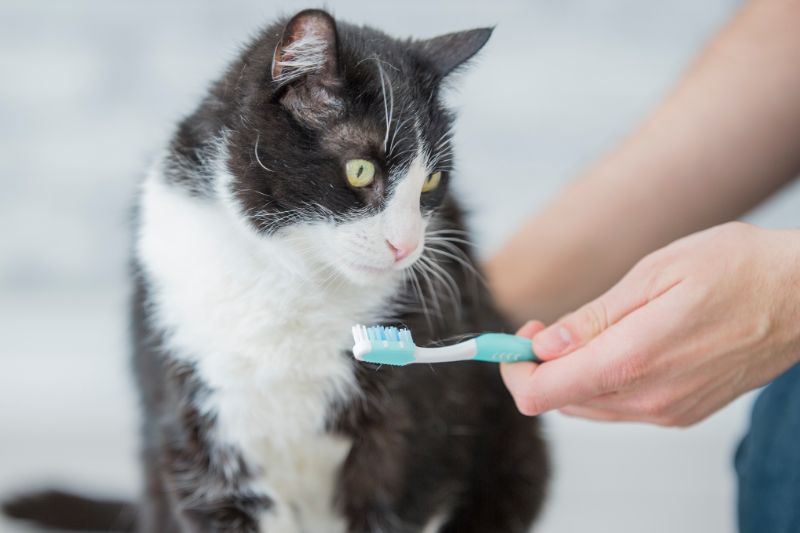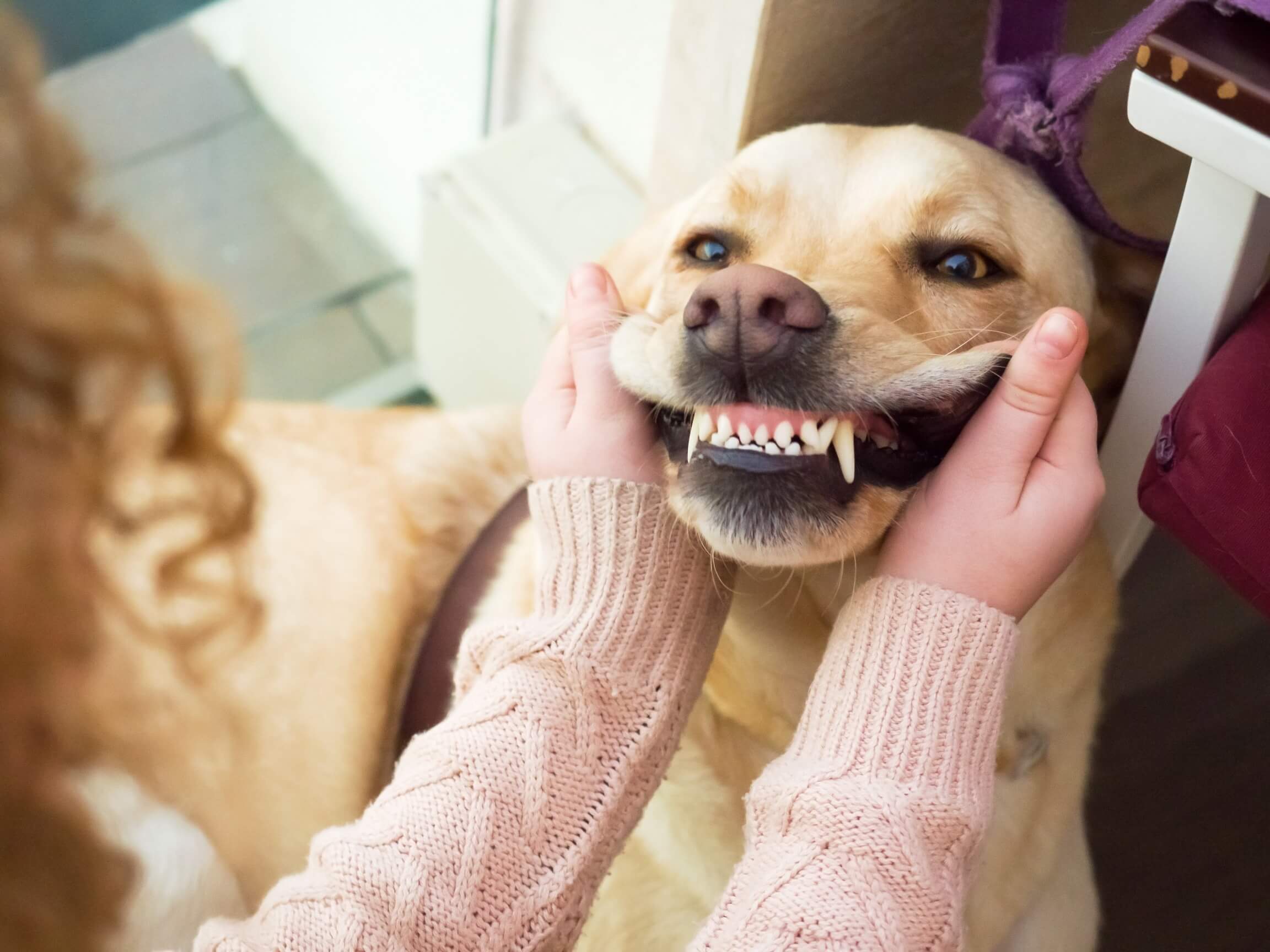Posts in Category: Pet Dental Care
The Right Stuff: Pet Home Dental Care

We brush our teeth twice a day, and the results of those efforts are definitely noticeable. Most of us wouldn’t dream of going an entire day (not to mention weeks, months, or years) without brushing, and we also benefit from regular cleanings, x-rays, and exams.
The same could be said for the benefits of dental care for our pets. And although applying these same principals to your pet could seem challenging at first, the health benefits to them are nothing short of astounding.
With that in mind, The Bluffs Pet Clinic takes a deeper look into why pet home dental care is so important.
Continue…Periodontal Disease in Pets
 If your pet’s bad breath drives you away as she tries to snuggle up to you on the couch, you may be thinking it’s time for a dental chew. But bad breath can signify deeper dental problems than a simple treat can fix – namely pet periodontal disease.
If your pet’s bad breath drives you away as she tries to snuggle up to you on the couch, you may be thinking it’s time for a dental chew. But bad breath can signify deeper dental problems than a simple treat can fix – namely pet periodontal disease.
The problems with periodontal disease go further than bad breath. With over 85% of pets affected by the time they reach 3 years of age, it’s no surprise that this topic gets a lot of our attention. Also known as dental disease, periodontal disease in pets can cause bleeding gums, tooth loss, and even systemic disease of the heart, liver, and kidneys.
Luckily, periodontal disease is preventable. We know that conscientious pet owners want to do the best they can for their pets. Here’s some information to help you do just that.
How Periodontal Disease Happens
Periodontal disease in pets is the progressive inflammation of the supporting structures of the teeth. Here’s how it workds:
- It starts when bacteria in the mouth form plaque that sticks to the teeth.
- Minerals in your pet’s saliva then bond with the plaque, causing it to harden into tartar.
- Bacteria that cling to the plaque and tartar then work their way under your pet’s gum line, causing gum inflammation (gingivitis).
- If tartar is not controlled, it can progress to periodontitis. When this happens, bacteria destroy the supporting structures of the tooth, including the soft tissues surrounding it, the root, and the bone below.
Signs of Periodontal Disease
Pet owners sometimes have a difficult time noticing the first signs of dental disease. We recommend annual preventive care visits in order to spot the signs of dental disease early and treat small problems before they become advanced.
Signs to look for include:
- Bad breath
- Drooling
- Red or bleeding gums
- Pawing at the mouth
- Pain or sensitivity
- Loss of interest in chew toys
- Difficulty eating (sometimes looks like messy eating)
- Chewing on one side of the mouth
- Sudden preference for soft food
It is rare that an animal will actually stop eating from dental disease, but you may notice changes in their interest or comfort while eating.
Treating and Preventing Periodontal Disease
Although dental disease is common, the good news is that it is preventable. Treatment and prevention of dental disease can add years to your pet’s life and help keep them comfortable and healthy. Here’s how we do it:
- Regular wellness exams, even for seemingly healthy pets
- Professional dental cleanings as recommended
- Digital dental x-rays to check for disease under the gum line
- At home care, including brushing your pet’s teeth daily (we can teach you how!)
If you have any questions about your pet’s health, please don’t hesitate to give us a call. Your team at The Bluffs Pet Clinic is ready to help!
Getting to the Root of the Matter: The Importance of Pet Dental Care
Similarly, pet dental care should be a regular part of your pet ownership responsibilities.

Female Hand holding toothbrush with toothpaste and yorkshire dog in background.
Most of us know that keeping our mouths clean and healthy is an important part of caring for ourselves. Chances are, you brush your teeth a few times daily and visit the dentist once or twice a year. Similarly, pet dental care should be a regular part of your pet ownership responsibilities.
Good home and professional dental care is essential to your pet’s health. We are all about prevention here at The Bluffs Pet Clinic, and by taking a proactive approach to your pet’s oral care, he or she has an excellent chance at a long, happy, and healthy life.
The Link Between Oral Health and Longevity
Periodontal disease, also known as dental disease, is one of the most common ailments seen by veterinarians. This is no surprise, considering that up to 85% of cats and dogs have some form of the disease by the time they reach 3 years of age.
Periodontal disease is an infection of the soft tissue and supporting structures of the teeth, caused by a buildup of bacteria along the gum line. If left untreated, periodontal disease can cause your pet significant pain, tooth loss, and may lead to a wide variety of systemic problems.
As dental disease progresses, bacteria make their way into your pet’s bloodstream and travel throughout the body, where they come into contact with vital organs such as the heart, kidneys, and liver, potentially causing significant damage.
By making your pet’s oral health a priority, you will be protecting him or her from some serious problems down the road. Having a healthy mouth can add years to your pet’s life.
Does My Pet Have Dental Disease?
Contrary to popular opinion, bad breath in pets is not normal and may be a sign that your dog or cat is suffering from dental disease. Other indications include:
- Excessive drooling, especially in cats
- Loose teeth
- Discolored teeth
- Swollen or inflamed gums
- Loss of appetite or difficulty eating
- Bleeding from the mouth
- Pawing at the mouth
If caught early, dental disease can be treated and many of its associated problems prevented. Give us a call if you notice any signs of dental disease in your pet.
Pet Dental Care at Home
Good home care is an essential component of your pet dental care routine. Not only will pet dental care at home prevent or slow the progression of periodontal disease, it will also allow you to become more familiar with your pet’s mouth and spot any emerging health issues before they become serious.
Brushing your pet’s teeth every day (or as often as possible) is the most effective way to care for their mouth.
You can purchase pet toothbrushes and pet-specific toothpaste (never use human toothpaste on a pet) at any pet supply store. Introduce your pet to brushing slowly and offer lots of praise along the way. Your veterinarian is a great resource when it comes to learning about home pet dental care.
Professional Pet Dentistry
In addition to brushing your pet’s teeth at home, your veterinarian will perform an oral examination on your pet at each wellness visit (recommended at least once per year). If it is determined that your pet could benefit from a full dental examination and cleaning, we will create an effective treatment plan and discuss all options for home and follow-up care.
We are committed to your pet’s health and happiness! Please let us know if you have any questions or concerns. Happy brushing!

